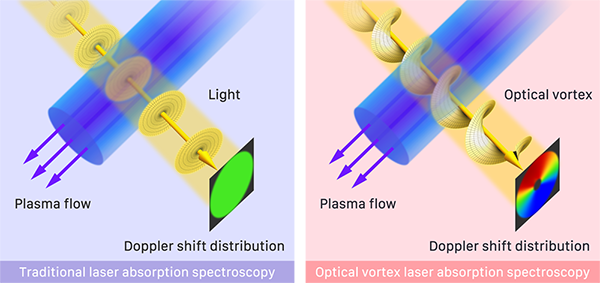October 13, 2023
Measuring flow with twisted light- Exploring New Possibilities in Laser Measurement –
Nihon University
National Institute for Fusion Science, National Institutes of Natural Sciences (NIFS)
Sojo University
Research Results (Press Release)Outline
Measuring particle flow from plasma to matter is critical regarding plasma-matter interactions. With a conventional laser, only the velocity of particles along the direction in which the light travels can be measured. Therefore, measurements cannot be made for a particle flux, for example, heading toward the reactor wall of a fusion device, because the wall obstructs the light path. A research group including Hiroki Minagawa, a third-year doctoral student at Nihon University, Professor Mitsutoshi Aramaki of Nihon University, Associate Professor Shinji Yoshimura of the National Institute for Fusion Science, and Associate Professor Kenichiro Terasaka of Sojo University has overcome the restriction on the direction of measurable velocity by using a laser with a helically twisted wavefront*1 called an optical vortex*2. This measurement method is named optical vortex laser absorption spectroscopy (OVLAS), and using optical vortices makes it possible to measure particle flows perpendicular to the direction of light. This technique is expected to significantly contribute to elucidating phenomena at the boundary region between matter and plasma.
A paper summarizing the results of this research was published in the online edition of Scientific Reports, the British scientific journal of Nature Publishing Group, on September 16, 2023.
Background
Plasma is a state in which atoms are ionized into ions and electrons and is used in many industries, including semiconductor manufacturing. Developing plasma fusion reactors as a next-generation energy source is also vigorously underway. In such advanced use of plasma, the energy of the active species produced by the plasma flowing into the substrate and the heat load on the reactor wall from the hot particles from the core plasma are crucial information. However, conventional laser beams can only measure the velocity of particles along the direction the light travels. Therefore, we have so far measured the perpendicular component to the substrate or reactor wall for particle fluxes incident on a substrate or reactor wall by injecting a light beam at an oblique angle. However, even with this method, there is a restriction on the optical path that can be secured, and there are cases where measurement is impossible. This situation has created a strong demand for expanding the degree of freedom of optical measurement in flow measurement.
Results
A research group including Hiroki Minagawa, a third-year doctoral student at Nihon University, Professor Mitsutoshi Aramaki of Nihon University, Associate Professor Shinji Yoshimura of the National Institute for Fusion Science, and Associate Professor Kenichiro Terasaka of Sojo University has successfully measured the plasma flow velocity by irradiating an optical vortex beam from a direction perpendicular to the plasma flowing inside a glass tube by using the Doppler effect*3 inhomogeneity that appears in the optical vortex absorption (Figure 1).
The relation between the wavefront of the light and the direction of motion of the atoms determines the Doppler effect in the interaction between light and atoms. In conventional plasma measurements, this Doppler effect is used to measure the velocity of atoms, but a light source using plane waves can only detect the velocity in the direction the light travels. This study addressed the issue by developing “optical vortex absorption spectroscopy,” which utilizes an optical vortex beam. Because the optical vortex has a helical equiphase surface, the relation between the uniform transversing plasma flow and the equiphase surface varies from place to place. Using this property, we have obtained the transverse flow velocity from the spatial variation of the Doppler effect in the interaction between the optical vortex and the atoms. This study demonstrates the capability of this technique to provide highly accurate measurements for gas velocities in the range of approximately 50 to 150 m/s.

Significance of Research Results and Future Developments
It has been generally accepted that only the velocity component of particles along the direction in which light travels can be measured, and it has been considered impossible to measure the velocity in the direction through which light cannot pass due to equipment limitations and other factors. This research demonstrates that transverse velocity can also be measured using optical vortices and opens up new measurement capabilities by taking advantage of the spatial structure of light. We plan to apply this technique to observing particle transport in the boundary region between plasma and matter.Glossary
*1 wavefront
In a wave that propagates while oscillating, a wavefront is a plane connecting places where the oscillation timing is the same.
*2 optical vortex
An optical vortex is light with a helical wavefront and a phase singularity at the center of the beam. In addition to attracting attention as light with orbital angular momentum, various applications are under investigation, including super-resolution fluorescence microscopy by S. Hell, winner of the 2014 Nobel Prize in Chemistry, optical vortex tweezers, and optical vortex multiplexing communications.
*3 Doppler effect
A phenomenon in which the frequency of a wave is observed as a different value than it actually is when the source of the wave and the observer are in relative motion in the direction across the wavefront.
Paper
Title: “Enhancement of Doppler spectroscopy to transverse direction by using optical vortex”
Authors: Hiroki Minagawa1, Shinji Yoshimura2,3, Kenichiro Terasaka4, Mitsutoshi Aramaki1
1 College of Industrial Technology, Nihon University
2 National Institute for Fusion Science, National Institutes of Natural Sciences
3 Center for Low-temperature Plasma Sciences, Nagoya University
4 Faculty of Computer and Information Sciences, Sojo University
Journal: Scientific Reports, vol. 13, 15400 (2023). (Published: September 16, 2023)
DOI: 10.1038/s41598-023-42517-z
Acknowledgments for Research Grants
This work was supported by JSPS KAKENHI Grant Numbers JP25287152, JP17H03000, JP18KK0079, JP21K03501, and JP21H01058 and supported in part by the NIFS Collaboration Research Program (NIFS13KOAP026).
